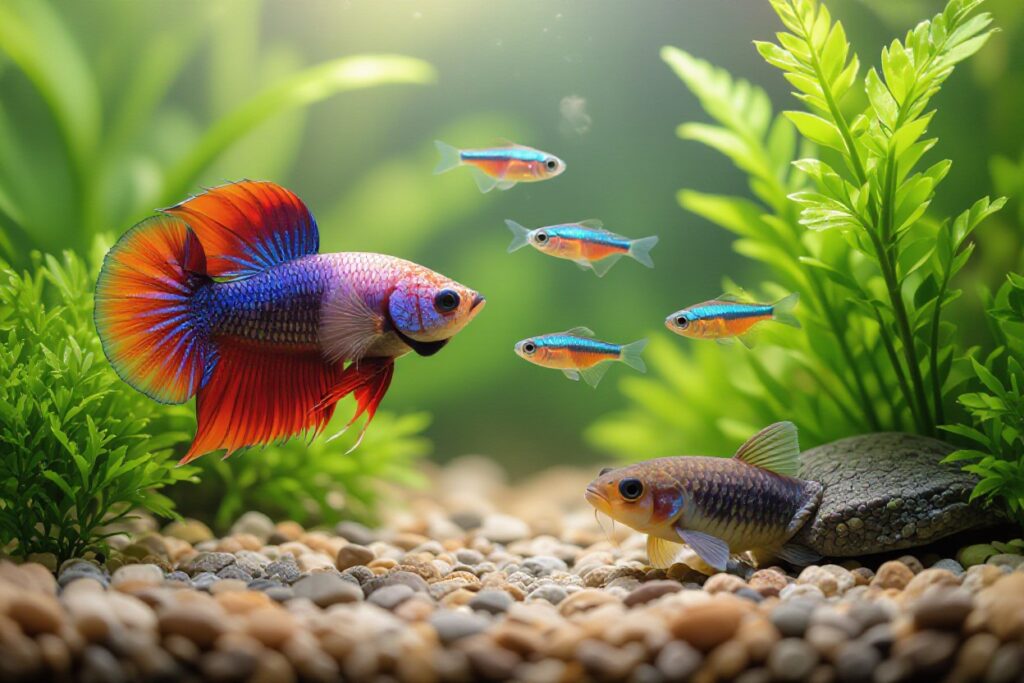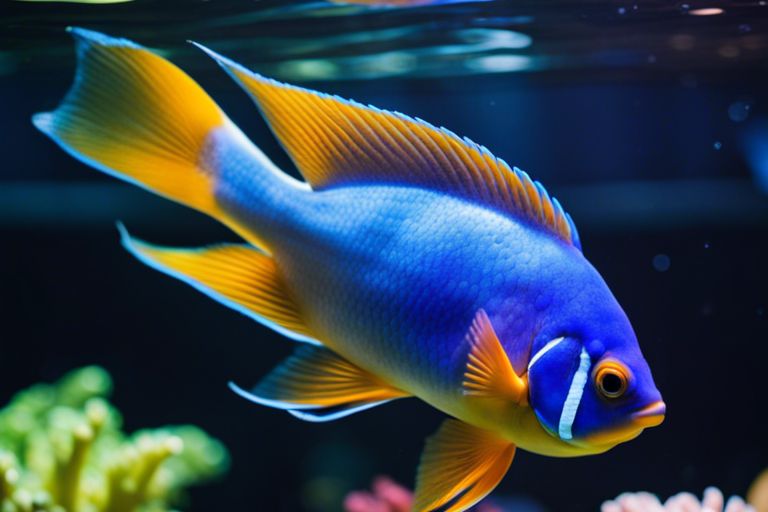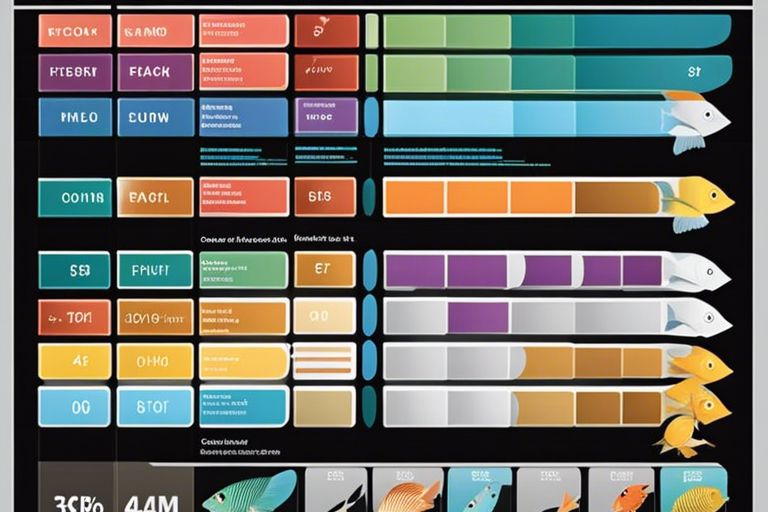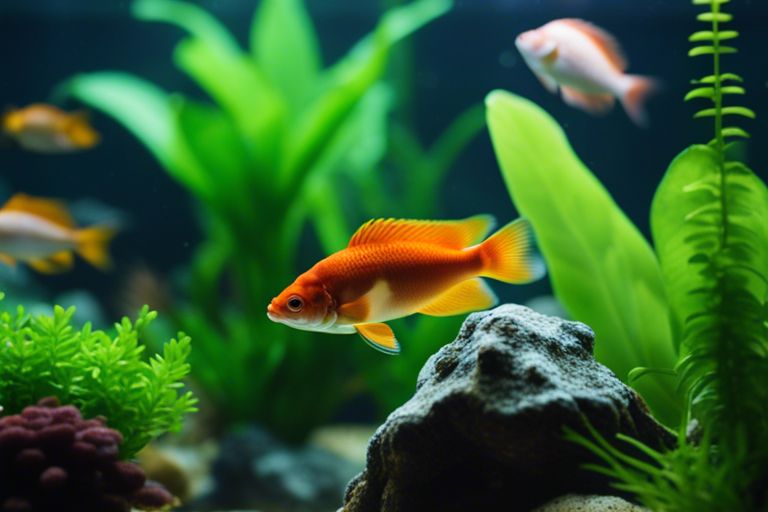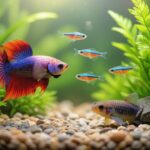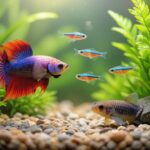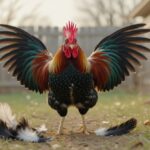Beginners often feel overwhelmed choosing the right 3 compatible fresh water fish, but with simple rules you can build a healthy community: focus on size and temperament compatibility, stable water parameters, and tank size limits; avoid species known for aggression or fin-nipping as they pose dangerous risks to smaller fish; when paired correctly, these beginner-friendly combinations offer peaceful interaction, easy feeding, and resilient behavior that helps you learn successful aquarium care.
Understanding Freshwater Aquarium Basics
Benefits of Freshwater Aquariums
You’ll notice freshwater setups are far more affordable and forgiving than marine tanks: many hardy species (guppies, platies, neon tetras) tolerate a wider pH range and lower maintenance. Expect startup costs around $100–$300 for a 10–20 gallon kit, and routine upkeep like weekly 10–25% water changes keeps parameters stable. Live plants reduce nitrates and create natural hiding spots, making community trios easier to keep healthy while you learn.
Common Beginner Mistakes
You often see newcomers add fish too quickly, overfeed, or skip water testing—each causes spikes in ammonia or nitrite. Avoid the “1 inch per gallon” rule without considering adult size and bioload, and never mix incompatible species (for example, male bettas with fin-nippers). Use a liquid test kit to keep ammonia and nitrite at 0 ppm and nitrates under 20–40 ppm.
More specifically, cycling the tank first prevents deadly ammonia/nitrite peaks: establish beneficial bacteria with a fishless cycle or a few hardy starter fish, then add stock slowly over weeks. Also check temperature ranges—most tropicals prefer 72–78°F (22–26°C)—and avoid sudden pH swings by using conditioned water and gradual changes.
Tank Size and Setup
For a stable three-fish community, a 10–20 gallon tank is the practical minimum; choose larger if any species reaches over 2–3 inches. Install a filter rated for at least 4× the tank volume per hour, a heater matched to tank size, and provide hiding spots with plants and driftwood. Position decor to create territories and reduce stress among your trio.
Drill down on stocking: base decisions on adult length and waste production—three small livebearers (1.5–2″ each) suit a 10G, while a trio including a 3–4″ platy or dwarf cichlid needs 20G+. Aim for filter turnover of 4–6×/hour, keep substrate clean with regular vacuuming, and place the heater where flow distributes heat evenly to avoid cold spots.
The Importance of Compatibility in Fish Selection
When assembling your trio, prioritize overlapping needs so each fish thrives; mismatched size, temperament, or water requirements leads to stress, disease, and lost fish. Match schooling requirements (many tetras need groups of 6+), avoid pairing fish with more than 2x size difference that may become prey, and choose species with similar temperature and pH ranges to prevent chronic stress and frequent parameter swings.
Aggression Levels
You should assess temperament: some species are fin-nippers (tiger barbs), others are territorial (male bettas, convicts). For a calm trio pick 2 peaceful schooling fish plus a non-territorial bottom-dweller, or ensure >6 individuals for schooling species to diffuse aggression. Watch for signs like torn fins or hiding; persistent chasing or targeting of long-finned fish indicates an incompatibility that needs immediate correction.
Environmental Needs
You must align temperature, pH and hardness: neon tetras prefer ~24°C (75°F) and pH 6.0–7.0, platies do well at 22–26°C and pH 7.0–8.2, corydoras like softer water and 22–26°C. Choose fish with overlapping ranges (±2°C, ±0.5 pH) to avoid repeated water adjustments that stress your trio and cause illness.
For a practical example, a 20‑gallon community with 3 guppies, 6 neon tetras, and 4 corydoras runs well at 24°C (75°F), pH 6.8–7.2 and GH 6–12 dGH; provide moderate flow, dense planting, and fine substrate for bottom-dwellers so each species finds its preferred microhabitat without competing for space.
Feeding Habits
You need to balance diets: omnivores (platies, guppies) accept flakes, while bottom-feeders (corydoras) require sinking pellets or wafers, and carnivores/bettas crave protein. Avoid mixing a strict herbivore with obligate carnivores unless you can reliably deliver species-specific portions. Uneaten food can spike ammonia and harm all fish, so tailor feed types and delivery locations.
Example feeding plan: feed flakes or micro-pellets once daily for surface/midwater fish, drop 1–2 sinking pellets for bottom-dwellers after 10–15 minutes, and offer frozen/brine shrimp once weekly. Portion amounts so food is consumed within 2 minutes to prevent overfeeding and subsequent ammonia spikes that threaten your tank’s stability.
Overview of Compatible Freshwater Fish
When building a 3 compatible fresh water fish trio, you should match size, temperament, and water parameters so each fish thrives; aim for species that share a temperature range and feeding style. For beginners, practical combos include platy + corydoras + guppy or harlequin rasbora + corydoras + dwarf gourami in a 20–30 gallon tank. Pay attention to aggression or fin-nipping (avoid tiger barbs) and provide hiding spots and substrate for bottom-dwellers.
Characteristics of Peaceful Fish
You want fish that are naturally non-territorial, small (typically <3 inches), and tolerant of group living; examples are neon tetra, harlequin rasbora, platy, and corydoras catfish. Such species usually prefer midwater or bottom niches without competing aggressively for the same space. Choose fish with similar diet and pH/tank hardness needs, and avoid known fin-nippers or large semi-aggressive species to keep your trio stable.
Ideal Temperatures for Freshwater Fish
Most beginner tropical trios do best between 74–78°F (23–26°C), while coolwater species like goldfish need 65–72°F—so don’t mix these. You should keep daily fluctuations within 1–2°F and use a reliable heater and thermometer. Rapid swings or sustained extremes stress fish and increase disease risk.
Temperature Ranges
| Range | Species / Notes |
|---|---|
| 74–78°F (23–26°C) | Guppy, Platy, Harlequin Rasbora — ideal for most beginner tropical trios |
| 72–76°F (22–24°C) | Corydoras spp. — comfortable in slightly cooler tropical temps |
| 65–72°F (18–22°C) | Goldfish, White Cloud — do not pair with tropicals |
You should aim for steady conditions: set your heater to a target within the species overlap, check a thermometer daily, and acclimate new arrivals slowly (15–30 minutes drip or floating bag method). Keep temperature drift below 2°F/day to avoid stress and illness, and adjust heater placement so the tank has uniform warmth.
Temperature Management Tips
| Action | Why / Details |
|---|---|
| Use a reliable heater | Maintains stable setpoint ±1°F |
| Place a thermometer | Verify actual water temp at different zones |
| Avoid rapid changes | Limit to 1–2°F per hour to prevent shock |
| Acclimate new fish | Drip or slow float for 15–30 minutes to match temp and chemistry |
Behavioral Traits
You should assess schooling tendency, territoriality, and activity level: schooling fish (neon tetra, rasbora) prefer groups of six+, bottom-dwellers (corydoras) forage together, and open-water mid-level swimmers (platy, guppy) are social without strict schooling. Watch for fin-nipping, chasing, or persistent hiding as signs of incompatibility; pick species whose natural behaviors don’t force constant competition for the same space.
In practice, you should plan habitat structure to match behaviors: provide open swimming areas for midwater fish, dense planting or floating cover for shy species, and sandy or smooth substrate for corydoras. Monitor interactions for 2–4 weeks—if you see repeated aggression (nipped fins, torn tails) or chronic stress (loss of appetite, faded color), separate offenders or rehome one species to restore balance.
Combo 1: Guppies, Corydoras and Platies
This 3 compatible fresh water fish combo works well in a 20–30 gallon community tank: guppies occupy the top, platies the mid-level, and corydoras clean the bottom. You should target 72–78°F and pH around 7.0, feed a mix of flakes and sinking pellets, and keep plant cover plus open swimming space. Watch for rapid breeding among livebearers and manage fry with plants or a breeder box.
Guppy Care and Characteristics
Guppies are lively surface swimmers, reaching about 1.5–2 in (4–5 cm)72–78°F and neutral pH, accept flakes and frozen foods, and thrive with gentle filtration. Males are colorful and numerous; females breed frequently, so plan for population control. Expect peaceful behavior but occasional fin-nipping in overcrowded tanks.
Corydoras: The Bottom Dwellers
Corydoras stay small (1–3 in) and should be kept in groups of five or more since you’ll see their best behavior in schools. You must use soft sand or smooth gravel to protect barbels, keep oxygenation high, and feed sinking pellets or blanched veggies. They prefer slightly cooler ranges near 72–78°F and are very sensitive to copper-based treatments.
For extra Corydoras care, you should provide plenty of hiding spots like caves and leaf litter and perform regular, small water changes (10–20% weekly) to avoid nitrate spikes. They do poorly with strong currents, so place them in calmer zones and use fine substrate to prevent barbel damage. Species examples like Corydoras paleatus and Corydoras aeneus are hardy choices for beginners when kept in groups of six to ten.
Platies: A Colorful Addition
Platies are hardy livebearers reaching about 2–2.5 in (5–6 cm)
To manage Platies, you should plan for population control: add dense plants like hornwort for fry refuge or move fry to a grow-out tank. They tolerate a range of hardness and do well with mixed veggie-and-protein diets; common issues include ich and fin rot if water quality drops. Adult platies make stable, colorful community members when you monitor breeding and stocking levels. This trio works well in a planted community tank of 15–20 gallons, balancing active schooling with micro-cleaners; neon tetras provide movement, cherry shrimp handle detritus and biofilm, and Otocinclus patrol algae. You should match water to soft-to-moderate GH and pH 6.5–7.5, keep stable temps around 74°F (23°C), and provide hiding spots so shrimp and Otos aren’t stressed by boisterous fish. Neon tetras reach about 1–1.5 inches (3–4 cm)
Cherry shrimp are excellent micro-cleaners, grazing on leftover food, biofilm and soft algae while adding color and low-cost breeding potential; a colony of 10–20 helps keep detritus low and provides live snacks for small tetras. Their small size—about 1–1.5 inches—means they won’t stress neon tetras but are vulnerable to copper-based meds. In practice you can use cherry shrimp to reduce manual cleaning: they eat uneaten food in crevices and reproduce quickly under stable conditions, often doubling a colony in 2–3 months with adequate hiding places. Keep water parameters steady—temperature 72–78°F, pH 6.8–7.5—and add leaf litter and moss to boost survival of juveniles. Otocinclus (Otos) are small, peaceful algae grazers, typically 1–2 inches (2.5–5 cm), that do best in groups of 4–6 and prefer established tanks with a steady supply of biofilm and soft algae. They won’t bother shrimp or tetras, but you should avoid sudden parameter swings and provide driftwood or smooth rocks where algae accumulates. For best results acclimate Otos slowly, feed supplemental blanched zucchini or algae wafers when natural algae is low, and monitor water quality closely—nitrates under 20 ppm and stable oxygenation are linked to higher survival. Many hobbyists report 80–90% longevity gains when introducing Otos as a small school to a mature, planted aquarium. This trio thrives in a 20–30 gallon community tank where mollies and swordtails share similar pH 7.0–8.0 and 72–78°F needs, while snails handle algae and detritus. You’ll get active mid-to-top swimmers plus a reliable clean-up crew, but expect livebearer breeding and occasional male chasing. Balance numbers (more females than males), provide plants and hiding spots, and you’ll maintain harmony between these hardy, beginner-friendly picks. You’ll appreciate mollies for their tolerance to slightly brackish water and wide color morphs like black, dalmatian and sailfin; adults average 3–4.5 inches. They accept flake, algae wafers and vegetable matter, so add blanched zucchini or spirulina. Keep water on the harder/alkaline side and provide calcium for shell and fin health; mollies breed frequently, so plan for fry management. Swordtails (Xiphophorus hellerii) sport the male “sword” and reach about 4–5 inches1 male:2–3 females ratio to reduce male–male and male–female harassment, and offer 20+ gallons with plants and swim space to limit territorial behavior. For deeper compatibility, note swordtails are semi-assertive: you should avoid housing multiple dominant males in tight quarters. Provide dense planting (Java fern, Vallisneria) and open swimming lanes; that reduces nipping and gives fry cover. Feed a varied diet—high-quality flake, frozen brine shrimp and vegetable matter—and monitor for fin damage. Water hardness around 10–25 dGH and steady temperatures prevent stress, and staggered introductions (add mollies first) often calms initial squabbles. Snails (nerite, mystery, Malaysian trumpet) make efficient cleaners: nerite snails eat algae without reproducing in freshwater, while mystery snails handle detritus but may nibble soft plants. You should add one nerite per 5–10 gallons or one mystery snail per 10–15 gallons, and supply calcium-rich foods or cuttlebone to keep shells strong. Avoid overstocking to prevent outbreaks. In practice, snails signal tank balance: a sudden population boom often means you’re overfeeding or have excess waste. You should control numbers by limiting leftovers, manually removing clutches (ramshorn/mystery) and choosing nerites if you want minimal reproduction. Also keep an eye on plants—mystery snails prefer decaying plant matter and will clean up, whereas some ramshorn species can multiply rapidly and become a nuisance; plan your species choice to match your maintenance tolerance. For your 3 compatible fresh water fish trios, match tank size to the combo (15–20 gal for small-schooling sets, 20–30+ gal for mixed mid-sized species), install a reliable filter rated for 4–6× tank volume per hour, use a heater to hold temperature steady, and let the tank fully cycle before adding fish; arrange open swimming areas plus hiding zones, use a fine substrate for plants, and plan weekly 20–30% water changes to keep parameters stable. Aim for 72–78°F (22–26°C) for most beginner trios, pH roughly 6.5–7.5 and GH 4–12 dGH depending on species; keep ammonia and nitrite at 0 ppm and nitrate under 20 ppm. You should stock cautiously (about 1 inch of fish per gallon as a rough guide) and match species by size and temperament so dominant fish don’t stress smaller tank mates. Use a mix of tall background plants (Amazon sword, Vallisneria), midground (Anubias, Java fern) and foreground/mosses for shrimp; provide driftwood, smooth rocks, and caves for Corydoras and Otocinclus to hide. Balance dense planted zones with open swim space, and choose inert decorations without sharp edges. Live plants reduce nitrate and offer grazing surfaces for otos and shrimp. Place hardscape to create flow paths and territories: position caves and root mats near filter outflow for oxygenation, keep some low-light corners for shy species, and use 2–3 inches of nutrient substrate under a 1–2 mm sand or fine gravel cap for root feeders. Avoid copper-based ornaments or treatments that are toxic to invertebrates. Choose a filter rated > tank volume ×4–6 per hour; canisters or HOB work well, while sponge filters are excellent in shrimp-heavy setups because they protect fry and shrimp. Maintain biological media, test ammonia/nitrite weekly, and perform 20–30% water changes weekly to keep nitrates low. Strong mechanical and biological filtration prevents the common issue of oxygen-depleting waste buildup. Seed new tanks with media from an established filter or use bottled nitrifying bacteria to speed cycling (usually 2–6 weeks). Clean mechanical media regularly but rinse biological media in tank water to avoid killing beneficial colonies. If ammonia spikes occur, increase changes and reduce feeding; prolonged elevated ammonia is dangerous and stresses all three species in beginner combos. In a 15–30 gallon community tank with your 3 compatible fresh water fish trios, you’ll balance top, mid, and bottom feeders by offering a mix of flakes, sinking pellets, algae wafers, and occasional frozen protein. Feed small portions that the tank consumes in about 2 minutes to protect water quality, and stagger feeds so the neon tetras, cherry shrimp, otocinclus, guppies, corydoras or platies each get appropriate food without competition. You must sort species into herbivores (Otocinclus), omnivores (Neon Tetras, Guppies, Platies), and scavengers (Corydoras, Cherry Shrimp) to match foods and feeding methods. Provide algae/vegetable-based items for algae-eaters and protein-rich options—sparingly—for omnivores; avoid feeding only high-protein meals since excess protein increases ammonia and stresses all tankmates. Give Neon Tetras small flakes or micro-pellets twice daily, Cherry Shrimp blanched zucchini or algae wafers and occasional sinking shrimp pellets, Otocinclus strict algae wafers/leaf veg, and Corydoras sinking pellets or bloodworm treats once or twice weekly. Vary textures so each niche gets food where it grazes. Practical examples: in a 20‑gallon Neon Tetra, Cherry Shrimp and Otocinclus setup feed 1 flake per tetra in the morning, a small algae wafer mid-day for otos and shrimp, then a half sinking pellet near the bottom at dusk for Corydoras if present. Use targeted feeding (feeding ring or dropping food near hiding spots) to reduce competition and keep water stable. Feed adult community tanks 1–2 times daily, offering an amount eaten in ~2 minutes; fry need 3–4 small meals. Use sinking foods for bottom-dwellers and surface flakes for mid/top swimmers, and employ a feeding ring, spot feeding with a pipette, or small tongs to direct food to specific species. For technique, morning feed the schooling/top dwellers (flakes), afternoon provide frozen/brine or veggie treats, and evening drop a sinking pellet for bottom feeders. Consider an automatic feeder for vacations, but test it first; overfeeding during unattended periods is the most dangerous mistake for your tank. Keep parameters steady so your trio thrives: aim for ammonia 0 ppm, nitrite 0 ppm, and nitrate below 20–40 ppm. Test weekly with a reliable kit, perform regular partial water changes, and avoid sudden shifts in pH or temperature greater than 1–2°F (0.5–1°C). Stable conditions reduce stress, limit disease, and help even beginner setups support 3 compatible fresh water fish successfully. Match pH to the species in your trio; most beginner community trios do best between 6.8–7.5. If you mix fishes like tetras (6.0–7.0) and guppies (7.0–8.0), aim near neutral ~7.0 to minimize stress. Test weekly, adjust slowly with buffer drops or substrate choices, and avoid swings larger than ±0.3 pH units in a week. For tropical community setups targeting 3 compatible fresh water fish, keep the tank between 74–80°F (23–27°C), with a comfortable middle of 76–78°F. Use a quality heater and external thermometer, and treat fluctuations over 2–3°F as stressful triggers to fish behavior and immune function. Use the rule of thumb 3–5 watts per gallon to size heaters and install a separate, accurate thermometer at the opposite end of the tank to spot gradients. When doing water changes, pre-warm replacement water to within 1–2°F of tank temperature, limit changes to 10–25% weekly, and avoid direct sunlight or drafty placements that cause swings. Temperature control at a glance Establish a weekly habit: test water, perform a 10–25% water change, vacuum the substrate, and clear visible algae. Clean filter sponges by rinsing in tank water only and replace chemical media per manufacturer timing to preserve beneficial bacteria. Consistency keeps your trio healthy and lowers outbreak risk. For a 20–30 gallon beginner tank hosting 3 compatible fresh water fish, schedule weekly partial changes (15–20%), monthly mechanical filter cleaning, and media replacement staggered every 3–6 months. Quarantine new additions for 2 weeks, use dechlorinator for source water, and log readings (pH, ammonia, nitrite, nitrate, temp) to spot trends early. Maintenance checklist Typical issues in community tanks include ich (white spot), fin rot, velvet, fungal infections and dropsy; they often stem from stress, poor water or overcrowding. You’ll see fast outbreaks in tanks with fluctuating temp or ammonia spikes, and juvenile fish are especially vulnerable. Treating early keeps losses low; if more than one fish shows symptoms within 48–72 hours, assume a contagious problem and act. You should quarantine new arrivals for 14 days, keep ammonia and nitrite at 0 ppm and nitrate under 20 ppm, and perform ~25% water changes weekly. Stable temps (example: 74–80°F for many tropical trios), proper stocking (no overcrowding), varied diet, and routine filter maintenance cut risk dramatically. Consider a UV sterilizer for high-bio load systems to reduce free-swimming parasites. Watch for clamped fins, frayed tails, white spots, discolored patches, bulging eyes or scales (dropsy), rapid gill movement, gasping at the surface, rubbing on decor, loss of appetite, or erratic swimming. You’ll often spot one clear sign before others—white spots usually mean ich, while fuzzy growths point to fungus. Any sudden change in behavior within days demands testing. When you see symptoms, test water immediately for ammonia, nitrite, nitrate and pH; many “diseases” are triggered by poor parameters. For example, if white spots spread quickly, raise the tank to 78–82°F for 7–10 days to speed the parasite lifecycle and combine that with medication. Also photograph symptoms, isolate obvious severe cases, and log progression over 24–72 hours to guide treatment choices. Begin by correcting water quality and isolating sick fish in a hospital tank. Use targeted remedies: short salt dips (1–3 g/L) for ectoparasites, antiparasitics like copper-based meds or malachite green for ich/velvet, and metronidazole or antibacterial treatments for internal parasites or bacterial infections. Follow label dosing and avoid copper in tanks with shrimp or snails. Decide between medicating the whole tank or a quarantine tank based on contagion and livestock: treat the entire tank for widespread parasites, but use a hospital tank for concentrated antibiotic courses. Most meds work over 7–14 days; if no improvement in 72 hours, reassess diagnosis, consult retailer or forum cases, and avoid repeated antibiotic use without clear need—overuse risks resistance and kills beneficial bacteria. Social dynamics determine whether your 3 compatible fresh water fish trio thrives: schooling species need group sizes (tetras/danios ~6+), bottom dwellers like corydoras prefer 4–6, and territorials (dwarf cichlids, bettas) claim ~20–30 cm territories. You should expect most conflicts in the first 72 hours and around feeding or breeding; mitigating factors are tank size (≥20 gallons for mixed trios), plenty of hiding spots, and compatible temperaments. Hierarchy forms fast: dominant fish show flaring, chasing, and priority at food, often within 24–48 hours. In a trio, size gaps over ~20% body length increase dominance odds. You should watch for persistent chasing or reduced feeding by subordinates and provide multiple feeding stations plus shelters to diffuse the pecking order; schooling species may rotate leaders while territorials do not. Check behavior daily, focusing on the first week and feeding times when aggression spikes. Look for torn fins, constant chasing, gasping, faded color, or one fish avoiding open areas. Do 10–15 minute focused watches, keep a simple incident log, and use a phone camera for 30–60 minutes to catch subtle harassment you might miss. If aggression shows up, note time of day, participants, and triggers (food, territory, breeding). Use clear dividers for short trials or rearrange décor to reset territories; adding hiding spots like PVC caves or dense plants reduces direct sightlines. Also track injury progression—photograph wounds daily—and assess whether adjustments (more cover, extra feeding spots, adding a small school to diffuse attention) reduce incidents within 48–72 hours. Separate fish when aggression causes repeated injuries, prolonged hiding, or food exclusion—especially if you observe blood, deep fin shredding, severe labored breathing, or rapid weight loss. Temporary separation for 24–72 hours can cool tempers and allow healing; permanent relocation may be needed for inherently territorial or chronically aggressive individuals. When isolating, use a hospital tank of at least 10 gallons with matched temperature and similar pH to avoid shock, plus sponge filtration and a hiding spot. Perform daily 20–30% water changes, monitor appetite and wound healing, and isolate sick or injured fish for 7–14 days or until behavior and feeding return to normal before considering reintroduction. You should aim for a stable, well-filtered tank—typically a 20–30 gallon minimum for small trios—kept at 74–78°F and pH 6.8–7.5. Cycle the tank fully before adding fish so ammonia = 0 ppm and nitrite = 0 ppm, with nitrate under 20 ppm. Use a filter turnover of ~4× tank volume/hour, follow a conservative stocking rule (~1 inch of fish per 2 gallons for beginners), and feed varied diets in small amounts twice daily. Watch schooling, territorial, and hierarchical patterns—some species (e.g., neon tetras) need groups, while others (e.g., danios) are high-activity swimmers. Keep in mind that schooling species need groups of 6+ to behave normally, and that male bettas can be aggressive toward similar-shaped fish. You should match activity level and size: avoid putting a 3″ carnivore with 1″ fish to prevent predation and stress. Signs of trouble include sustained chasing, fin nipping, clamped fins, color loss, or hiding; mitigate by rearranging decor, increasing cover, or removing the aggressor. Quarantine new arrivals for 2 weeks to observe behavior and disease. If aggression centers on territory, add vertical structures and visual barriers or adjust stocking ratios—keeping species with similar temperament and size reduces confrontation. You should provide multiple refuges: aim for at least 2–3 hiding spots in a 20-gallon tank (caves, PVC, dense plant clumps) plus open midwater for active swimmers. Use hardy live plants like Java fern, Anubias, and Amazon swords, driftwood, and smooth rock to break lines of sight and reduce stress. Place floating plants to soften lighting for shy fish and vary flow so bottom-dwellers have calm zones. Place hides at different heights—caves and rock piles on the substrate, midwater tangles from stem plants, and floating cover at the surface—to create microhabitats. Anchor moss or Anubias to driftwood for shading and grazing, and ensure openings are wide enough for larger fish but snug for small fish to escape. Inspect and clean decor monthly; avoid sharp edges that can cause fin damage and use natural materials to buffer water chemistry where needed. Excess light, overfeeding and high nitrate or phosphate levels commonly trigger algae in beginner tanks; you’ll see green water, slimy glass, or filament clusters on plants. Reduce light to 6–8 hours, perform 25% weekly water changes, and limit feedings to once a day with only what your fish eat in two minutes. Use algae eaters like Otocinclus or nerite snails for persistent patches. The Signs like clamped fins, rapid breathing, faded color and hiding usually point to stress from bad water parameters, sudden temperature swings, or bullying; test for ammonia=0 and nitrite=0, keep nitrate under 20 ppm, and maintain stable temperature ranges for your species. Provide hiding spots, check stocking levels, and isolate aggressive individuals when needed. The For specifics, many small community trios (e.g., tetras + corydoras + otos) prefer 22–26°C (72–79°F) and pH 6.5–7.5; if you add a betta, keep temperature 24–27°C (75–80°F) and avoid fin-nippers. Quarantine new fish 7–14 days and reduce handling during acclimation; sudden 2–3°C shifts can trigger loss of appetite and disease. The Size, temperament and preferred water parameters determine whether species coexist; avoid pairing large, fast biters with small schooling fish, and check adult sizes—small rasboras or tetras need groups of 6+, while bottom dwellers like corydoras should be in groups of 3–6. Match diet types and activity levels to reduce conflict. The Example beginner-friendly trios: 1) Neon tetras (6+) + Corydoras pygmaeus (4) + Otocinclus (2–3) in a 20–30 gallon mature tank; 2) Platies (3) + Corydoras (4) + Nerite snail in a 20 gallon; these combinations align temperature and diet and minimize aggression—always check adult sizes and provide plants and hiding places before finalizing your setup. The The 3 compatible fresh water fish examples show how matching size, temperament, and water parameters makes beginner tanks successful; if you select compatible trios, provide the right tank size, steady feeding, and filtration, you’ll maintain a peaceful community—setups that suit your space and chemistry, plus regular observation, keep your fish healthy and easy to care for. A: Below are multiple beginner-friendly trios that reliably work together when tank size and basic care needs are met. Each trio lists typical adult size, temperament, ideal tank size, and simple feeding notes so you can pick a setup that fits your space and schedule. 1) Neon/Glowlight Tetras + Corydoras Catfish + Dwarf Livebearer (Endler’s or Guppy) 2) Harlequin Rasboras + Otocinclus + Dwarf Rainbow (or Cherry Barb) 3) Platies + Bristlenose Pleco (juvenile or small adult) + White Cloud Mountain Minnows (cooler option) 4) Zebra Danios + Corydoras + Mystery Snail (active, low-maintenance trio) General notes for all trios: A: Compatibility depends on a few practical, testable factors. Use these to evaluate any potential trio before purchase. 1) Size and growth potential 2) Temperament and social behavior 3) Water parameters: temperature, pH, hardness 4) Diet and feeding strategy 5) Activity level and tank zone 6) Reproductive behavior and population control 7) Disease susceptibility and quarantine 8) Space and stocking density How to apply these factors for “3 compatible fresh water fish” A: Follow a clear setup and maintenance plan to keep your trio healthy and thriving. Steps below cover tank size, cycling, equipment, aquascape, feeding schedule, and routine maintenance with example setups. 1) Tank size and equipment 2) Cycling the tank 3) Aquascape and planting 4) Feeding considerations 5) Maintenance schedule 6) Quarantine and disease management 7) Example beginner setup (20–30 gallon) Final practical tips This plan covers the necessarys to set up and maintain a successful community using 3 compatible fresh water fish: choose species with similar water needs, create varied tank zones, feed appropriately, and keep a consistent maintenance routine.Combo 2: Neon Tetras, Cherry Shrimp and Otocinclus
Neon Tetra: A Schooling Fish
Benefits of Cherry Shrimp
Otocinclus: The Algae Eater

Combo 3: Mollies, Swordtails and Snails
Mollies: Hardiness and Variety
Swordtails: Physical Traits and Compatibility
Snails: Clean-Up Crew
Tank Setup Guide
Ideal Tank Conditions
Decoration and Plant Selection
Water Quality and Filtration
Feeding Multiple Species
Understanding Dietary Needs
Balanced Diet for Different Species
Feeding Schedule and Techniques
Water Parameters and Maintenance
Ideal pH Levels
Temperature Control
Target range
76–78°F (24–26°C) for mixed beginner trios
Heater sizing
3–5 W per gallon
Monitoring
Digital or stick thermometer; check daily
Safe change rate
Keep shifts ≤1–2°F during water changes
Risk signs
Rapid gasping, clamped fins, hiding — reduce swing
Regular Maintenance Routine
Water changes
10–25% weekly (15–20% ideal)
Water testing
Weekly: pH, ammonia, nitrite, nitrate
Filter maintenance
Rinse mechanical media monthly; stagger replacements
Gravel vacuuming
Every 1–2 weeks during water change
Quarantine new fish
At least 2 weeks
Common Diseases in Freshwater Fish
Preventing Disease Outbreaks
Signs of Illness in Fish
Treatment Options
Social Behavior and Interactions
Understanding Fish Hierarchy
How to Monitor Interactions
When to Separate Fish
Setting Up a Community Tank
Community Tank Essentials
Behavioral Adaptations
Creating Safe Spaces

Troubleshooting Common Issues
Algae Growth Troubles
Fish Stress Factors
Compatibility Questions
Conclusion
FAQ
Q: What are good 3 compatible fresh water fish combinations for beginners?
– Typical members: 6–8 Neon or Glowlight Tetras, 4–6 Corydoras (Panda or Bronze), 3–4 Endler’s or small guppies.
– Adult sizes: Tetras 0.8–1.5 in, Corydoras 1–3 in, Endler’s/Guppies 1–2 in.
– Temperament: Peaceful schooling fish (tetras) + bottom-dwelling peaceful scavengers (corys) + livebearers with mild activity. Low aggression, good for planted tanks.
– Tank size: 20–30 gallons minimum for a stable, comfortable community.
– Water: Neutral to slightly acidic pH 6.5–7.5, temperature 72–78°F (22–26°C).
– Feeding: Flake or micro pellet for tetras and livebearers; sinking pellets and occasional frozen bloodworms for corys. Feed small portions once or twice daily.
– Why this works: Schooling fish stay in the midwater, corydoras occupy the bottom, livebearers add color and activity in the top/mid levels; similar diets and water needs make mixing easy.
– Typical members: 8–10 Harlequin Rasboras, 4–6 Otocinclus catfish, 3 Dwarf Rainbow or 6 Cherry Barbs.
– Adult sizes: Rasboras 1.5–2 in, Otos 1–2 in, Cherry Barbs 1.5–2 in, Dwarf Rainbow ~2 in.
– Temperament: Mostly peaceful; barbs chosen here are the calmer dwarf types. Otos are gentle algae grazers.
– Tank size: 20–30 gallons to allow proper schooling and grazing areas.
– Water: pH 6.5–7.5, temperature 72–78°F (22–26°C).
– Feeding: Flake/flake alternatives for rasboras/barbs; algae wafers and blanched veggies for otos. Many will accept frozen or live foods occasionally.
– Why this works: Balanced tank roles (upper/mid schooling, bottom algae control), compatible activity levels, and similar water preferences.
– Typical members: 4–6 Platies, 1 Bristlenose Pleco, 6 White Cloud Mountain Minnows (if maintaining slightly cooler temps).
– Adult sizes: Platies 2–2.5 in, Bristlenose 4–6 in, White Cloud Minnows 1.5–2 in.
– Temperament: Platies are peaceful livebearers; plecos keep hard surfaces clean; White Clouds are small, hardy schooling fish that tolerate lower temps.
– Tank size: 20–30 gallons or larger if pleco grows to mid-range size.
– Water: pH 7.0–7.8 for platies, but White Clouds prefer cooler, neutral pH; aim for 68–76°F (20–24°C) if combining, or choose a warmer small-minnow alternative if you want 74–78°F.
– Feeding: Omnivorous diet: flakes, vegetable matter, occasional sinking tablets for pleco.
– Why this works: Omnivore/algivore mix covers different food layers and helps keep the tank clean; platies and White Clouds add bright color and activity without aggression.
– Typical members: 6–8 Zebra Danios, 4 Corydoras, 1–2 Mystery Snails.
– Adult sizes: Danios 1.5–2 in, Corydoras 1–3 in, snails vary.
– Temperament: Energetic danios, peaceful bottom helpers, very low-maintenance invertebrate.
– Tank size: 15–20 gallons minimum; 20+ recommended for stable water.
– Water: Hardy ranges; pH 6.8–7.8, temp 68–75°F (20–24°C).
– Feeding: Danios: flakes/pellets; corys: sinking foods; snails: algae, blanched veg.
– Why this works: Wide temp tolerance and non-aggressive interactions make this a forgiving beginner trio.
– Choose fish sizes that will be peaceful as adults; avoid mixing large/small that could be eaten.
– Start with small numbers and add slowly after the tank is cycled and stable.
– Provide 2–3 hiding places and live or hardy plants to reduce stress.
– Use the phrase “3 compatible fresh water fish” as a planning model: pick three species that occupy different niches (top/mid/bottom), share similar water needs, and have non-aggressive temperaments.Q: What compatibility factors should I check when choosing 3 compatible fresh water fish?
– Check adult size, not juvenile size. A tiny fish now can become lunch later. If one species grows significantly larger, it may bully or eat smaller tankmates.
– Match fish with similar maximum sizes or ensure there is ample space and hiding spots for smaller species.
– Aggression: Avoid mixing known fin-nippers or territorial species with long-finned, slow, or shy fish.
– Territoriality: Males of some species (e.g., certain cichlids) become territorial in breeding condition. For beginners, stick to non-territorial community fish.
– Schooling needs: Many small fish (tetras, rasboras, danios, minnows) need groups of 6+ to feel secure. If you plan a trio, ensure the school species is represented in adequate numbers—your “3 compatible fresh water fish” plan may include one schooling species plus two other species in smaller numbers.
– Match species that share a similar temperature range (within ~4–6°F/2–3°C) and pH preferences.
– Tropical community fish commonly thrive at 72–78°F and pH 6.5–7.5; if a species prefers much cooler or warmer water, avoid mixing.
– Check hardness (soft vs hard water) requirements; some livebearers prefer harder water, while many tetras prefer softer water. If mismatched, one group can show chronic stress.
– Omnivores, herbivores, and carnivores can mix if feeding routines cover all needs. But specialized feeders (large predators, strict carnivores) are harder to pair with small community fish.
– Consider feeding layers: top feeders, midwater eaters, bottom feeders. Choose fish that will not starve one another out of food access; feed at multiple levels if needed.
– Be wary of species that require live or frozen-only diets if you want an easy routine.
– Active swimmers (danios) may stress shy species. Combine active midwater schools with peaceful, robust tankmates.
– Balance top/mid/bottom dwellers so there’s no overcrowding of one water column.
– Livebearers and prolific spawners can quickly overrun a small tank if you don’t plan for fry. If you prefer no population growth, choose non-breeding species or plan to remove fry.
– Some breeding behaviors increase aggression (nesting, guarding). Avoid species with pronounced parental aggression in small community tanks.
– Some species are more prone to certain diseases. Quarantine new fish for 2–4 weeks and observe for signs before mixing.
– Compatibility also means biosecurity: a healthy, cycled tank plus quarantined additions reduces risk.
– Use the “inch-per-gallon” rule as a very rough starting point but prioritize adult behavior and biofilter capacity over that rule. A better approach: estimate bioload and seating space—active swimmers need more open water, bottom dwellers need substrate space.
– For many beginner trios, a 20–30 gallon tank gives flexibility and stability.
– Start by picking one schooling species as the centerpiece, one peaceful bottom-dweller for cleanup, and one colorful midwater/top-dweller or small pleco/snail for variety.
– Cross-check water parameters and feeding types; if any mismatch appears significant, swap one species for a closer match.
– If unsure, consult care sheets for each species and prioritize species with broad, overlapping tolerances (e.g., tetras, danios, corydoras, livebearers, otos).Q: How do I set up and maintain a beginner-friendly community tank for three compatible freshwater fish?
– Tank size: 20–30 gallons minimum for most beginner trios. Larger tanks are more forgiving and stable.
– Filter: Use a filter rated for at least the tank volume; hang-on-back (HOB) or canister filters are good choices. Ensure gentle flow for species that dislike strong currents.
– Heater: Use an adjustable aquarium heater and a reliable thermometer; aim for a stable temperature within the species’ preferred range.
– Lighting: Moderate lighting supports live plants and shows off colors. Use a timer for a consistent 8–10 hour photoperiod.
– Substrate: Sand or fine gravel for corydoras; use plant-friendly substrate if keeping live plants.
– Decorations and hiding spots: Provide driftwood, caves, and plants to create territories and reduce stress; leave open swimming areas for midwater fish.
– Cycle the aquarium before adding fish to establish beneficial bacteria that process ammonia and nitrite.
– Methods: fishless cycling with ammonia source or slow addition of hardy cleaners like snails plus regular testing. Aim for 0 ppm ammonia, 0 ppm nitrite, and stable nitrate before adding most fish.
– Add fish slowly after cycling: start with the species that produce the least bioload (corydoras or otos) and add others over 1–2 weeks while monitoring water chemistry.
– Plants: Java fern, Anubias, Amazon sword, and floating plants are beginner-friendly. Plants help with nitrate reduction and provide hiding spaces.
– Layout: Create zones—open midwater for schooling species, planted/broken hardscape for shy fish, smooth substrate for bottom dwellers.
– Lighting and CO2: Not required for low-light plants; avoid high CO2 systems for beginners.
– Feed small amounts once or twice daily; any uneaten food should be removed after 2–3 minutes to prevent ammonia spikes.
– Use a mix of flake/pellet, frozen/live treats weekly, and sinking foods for bottom dwellers.
– If one species is a grazer (otos, plecos), provide algae wafers and blanched vegetables to supplement their diet.
– Rotate foods to ensure balanced nutrition—spirulina flakes, quality pellets, occasional bloodworms or brine shrimp.
– Daily: quick visual check for behavior, filter operation, temperature.
– Weekly: 10–25% water change depending on stocking and nitrate levels; siphon substrate to remove detritus.
– Biweekly/monthly: clean filter media in tank water (not tap water) to retain bacteria; replace carbon or chemical media as needed.
– Test water weekly for ammonia, nitrite, nitrate, and check pH/temperature trends.
– Quarantine new fish for at least 2 weeks in a separate tank to observe and treat any signs of disease.
– Observe for common signs: clamped fins, lethargy, discoloration, abnormal breathing. Treat promptly with appropriate medications after diagnosis.
– Filter: HOB with sponge prefilter or small canister.
– Heater: 100–150W adjustable.
– Substrate: fine gravel or sand.
– Plants: Java fern attached to driftwood, Anubias, and floating duckweed or frogbit.
– Decorations: 3–4 hiding spots (rock or terracotta caves), open swimming area.
– Stocking: 8 Harlequin Rasboras, 5 Corydoras (Panda), 3 Endler’s/guppies OR alternative trio from first FAQ answer.
– Routine: cycle tank fully before stocking, feed twice daily small portions, 20% weekly water change, weekly testing, quarantine new additions.
– Avoid adding all three species at once to a newly cycled aquarium; add gradually over 1–3 weeks to keep ammonia low.
– If aggression or compatibility issues arise, rehome the problematic species rather than trying aggressive treatments.
– Keep a simple log of water tests and maintenance tasks for the first 2–3 months to spot trends.

